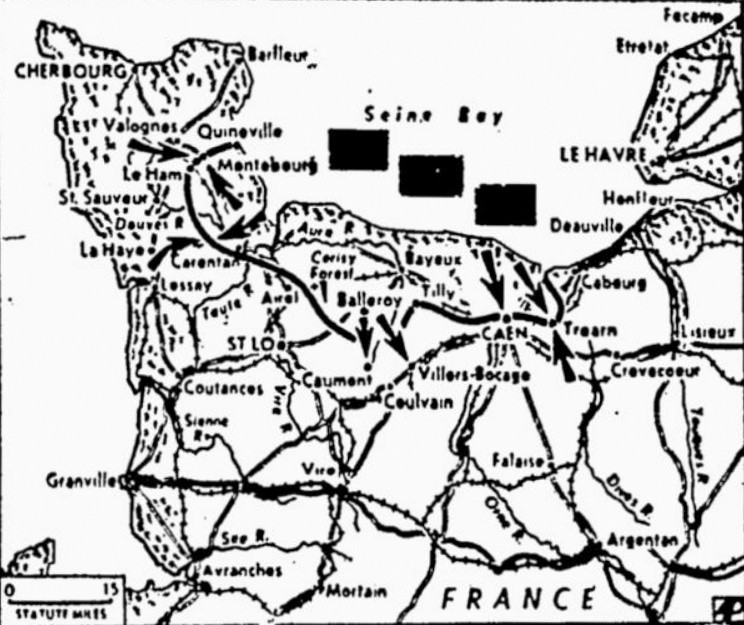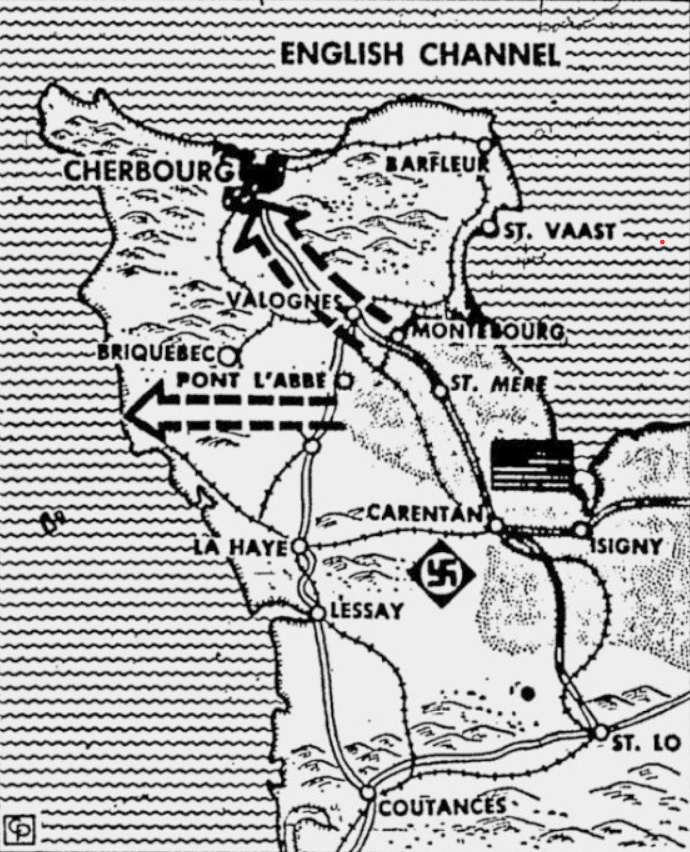Bisher über 300 Feindpanzer vernichtet
Berlin, 14. Juni –
Außer den Hunderten von Panzern, die unsere Seestreitkräfte und Kampfflugzeuge bei der Versenkung von Panzerlandungsschiffen und Transportern vernichteten, haben unsere Heeresverbände während der ersten Invasionswoche in den Kämpfen an der normannischen Küste weit über 300 feindliche Panzer zur Strecke gebracht. Davon wurden allein 39 noch am Montag bei Tilly-sur-Seulles abgeschossen. Der erste Tag der zweiten Invasionswoche brachte dem Feind wieder hohe Verluste an Panzern, Kriegsgerät und Menschen. Südlich Tilly-sur-Seulles war eine stärkere feindliche Aufklärungsgruppe nach Süden vorgestoßen. Herangeführte Eingreifverbände stellten sie zum Kampf und rieben sie auf. Hierbei wurden weitere 15 britische Panzer und Panzerspähwagen vernichtet. Zahlreiche Gefangene fielen in unsere Hand.
Schwere Kämpfe gegen nordamerikanische Truppen entwickelten sich am Elleabschnitt sowie westlich und nordwestlich Carentan. Die nördlich der Straße Bayeux-Saint-Lô im Schutz des großen Waldgebietes des Forêt-des-Biards vordringenden Nordamerikaner erkämpften den Übergang über den Ellebach, wurden jedoch an der Höhenschwelle bei Couvains abgefangen. Auch hier und in den Höhen westlich Carentan hatte der Feind wieder sehr schwere Verluste. In dem Überschwemmungsgebiet nordöstlich Carentan sickerten nordamerikanische Einheiten über schmalen Landstreifen nach Westen in unsere Linien ein und konnten einige Dörfer besetzen. An diesem Punkt und bei Montebourg sind eigene Gegenstöße im Gange.
Im Großen gesehen hat sich die Lage auch am 8. Invasionstage nicht wesentlich geändert. Vorgeprellte feindliche Teilkräfte wurden vernichtet oder nach örtlichen Geländegewinnen durch Gegenstöße abgefangen. Die Kämpfe waren wieder durch erhebliche Verluste des Gegners gekennzeichnet, der oft von unseren bis zur Unkenntlichkeit getarnten Grenadieren auf kürzeste Entfernung zusammengeschossen wurde.
Überall Trümmer und Leichen
Bern, 14. Juni –
In einem Frontbericht aus der Normandie, den die Schweizer Illustrierte Zeitung veröffentlicht, schreibt der amerikanische Kriegsberichterstatter Henry Gorrell unter anderem: Die Verluste unserer Truppen sind bis jetzt schwer gewesen. Bei einem Bauernhof, wo ich vor ein paar Stunden war, sind alle zu diesem Gebäude führenden Wege buchstäblich mit Gefallenen bedeckt gewesen, unter ihnen auch von Luftlandetruppen. Die Gleitflugzeuge, mit denen sie ankamen, sind riesige Apparate, überall liegen ihre zertrümmerten Reste umher. Leichen amerikanischer Soldaten liegen umher und manche baumeln in den Riemen ihrer Fallschirme, als ob sie am Galgen hingen. Niemand hat bisher Zeit und Möglichkeit gehabt, die Gefallenen zu begraben.
Späh wagen im Handstreich erbeutet
Berlin, 14. Juni –
Im Kampfraum von Caen leistete sich ein blutjunger Grenadier der SS-Panzerdivision „Hitler-Jugend“ ein besonderes Bravourstück. Einige Meter von seinem Deckungsloch entfernt, erreichte ein gepanzerter britischer Spähwagen eine Straßengabel. Als die Fahrer anhielten, um sich zu orientieren, robbte der Grenadier von der Seite her an den Spähwagen und klopfte mit seiner Maschinenpistole mehrmals an die Panzerung, bis der Turmdeckel von innen geöffnet wurde. Im gleichen Augenblick sprang der beherzte Grenadier auf das Fahrzeug und setzte durch wohlgezieltes Feuer die dreiköpfige Besatzung außer Gefecht. Der Spähwagen fiel mit noch laufendem Motor in unsere Hand.

